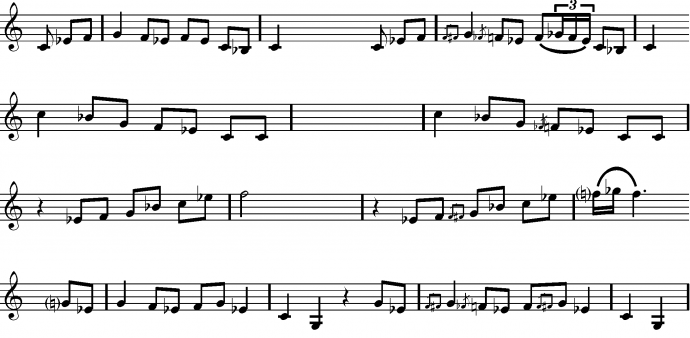Blues Phraseology in Jazz
by Steve Russell, piano lecturer at JMI
This is the first in a series of articles aimed at developing a better understanding of the nature of blues phraseology and its importance in jazz and bebop.
Part 1 is designed to clarify the distinction between the true nature of blues phraseology and the somewhat troublesome “Blues Scale”, and to guide students toward a better understanding of blues phraseology.
Part 2 demonstrates how blues phraseology can be utilised within jazz and bebop in the context of the “major ii-V-I”.
Part 3 demonstrates how blues phraseology can be utilised within jazz and bebop in the context of the “minor ii-V-i”, and as jazz language against the various secondary dominant chords that can appear in minor key harmony.
Caveat 1: Countless scholarly works exist that discuss the origins and cultural significance of the Blues and the Blues Scale, and these articles do not intend to add to them.
Caveat 2: The articles are not about the 12-bar form known as “the blues”. They are inspired by a definition of the blues given by Reggie Thomas during an Essentially Ellington workshop:
The blues is a way of articulating melody.
Part I – Blues Phraseology v. Misleading Blues Scale
This article is pragmatically aimed at providing a direct method of understanding and reproducing blues phraseology. Familiarity and competence with blues phraseology in all keys is a necessary first step before exploring ways of utilising it in jazz and bebop settings.
A Very Quick Look at the Origins of the “Blues Scale”
In The Music Of The Most Ancient Nations (Engel, C. 1870 John Murray, London) Dr Carl Engels describes the tuning of a Senagambian mbira (thumb piano) as: A D#/Eb E D G A C D
Although the order is different, this clearly constitutes what is now known as the A Blues Scale or the A minor Blues Scale. (24% of kidnapped Africans transported to America came from this region, now Senegal and Gambia.) In early twentieth century America, “Western” music theorists analysed African American music and independently derived more or less the same scale.
Why is the Blues Scale Misleading?
The Blues Scale is best likened to an alphabet of the blues – a collection of elements that can be assembled into both meaningful and meaningless combinations, just like the English alphabet. Knowledge of the scale does not guarantee or even engender knowledge of the language – imagine learning the Coptic alphabet and then assuming you could speak Ancient Egyptian.
Blues phraseology is a language. Languages are learned by listening and copying. The only way the Blues Scale can help in the learning process is to narrow down the choices when attempting the copying.
The Blues Scale is also misleading because it simply presents six notes without differentiating their function or hierarchy.
A Better Description of Blues Phraseology.
Blues melody is fundamentally pentatonic. You can reduce most blues melody to a simple pentatonic melody, but in doing so some of the bluesy nature is lost. The “blue note” is best thought of, not as a melodic element in itself, but rather as part of the embellishment of the notes between which it sits, the 4th and 5th. It is this embellishment that gives the pentatonic melodies their “bluesiness”.
If we are to have an “alphabet” of the blues, it needs to look more like this:
Fig 1: Alphabet of Blues Elements

This “alphabet” contains the five unembellished notes of the pentatonic scale, (since they are not necessarily always embellished,) and the most common examples of embellished versions of the 4th and 5th degrees. (The list of embellishments is in no way exhaustive.) Notice that the “blue note” does not appear as a discreet element.
Converting Pentatonic Melody to Blues Language
Now consider the following melody snippet – play it on your instrument with a swing feel, and you will hear that it is clearly a bluesy melody.
Fig 2: Unembellished pentatonic melody

Now here are two examples of the same snippet, with some blues embellishment added.
Fig 3: Pentatonic melody with blues embellishments

(The embellishments are written for piano. If your instrument is capable of bending notes, that is an equally legitimate way of achieving the blues effect. Guitarists can slide, bend, hammer-on and pull-off to achieve a variety of expressions.)
The next question should be “How do I articulate this?”, and the answer is “By listening and copying.” The notation could be expanded to include a variety of articulation marks regarding note-to-note dynamic differences, legato and staccato, but this would not guarantee the correct execution. Only listening can do that.
The following is a collection of familiar blues phrases presented first as pentatonic melodies, then with blues embellishment.
Fig 4 Some pentatonic melodies and their bluer versions

How to practice blues phraseology
There are probably a million different ways, but here is a method that allows you to focus on a single scale for as long as you like, while still providing a little harmonic movement.
Use iRealBook or your preferred sequencing software to set up a loop – one bar of Dm7, one bar of G7, and play blues language in Dm. You’ve heard plenty of blues language in every rock guitar solo ever recorded; try to imitate the phraseology that you are familiar with.
When you’re ready, transpose to a new key. Repeat through all keys. (This is not one day’s work, but you could reasonably expect to achieve some proficiency in 12 keys within a week.)
You need not wait until you have achieved mastery of all 12 keys before proceeding to the next part in this series; in fact, a quick look at Part 2 might convince you of the value of applying Part 1.
For more information about Steve Russell, you can visit his website here. If you want to learn piano and more about blues phrasing from Steve, check out our Bachelor and Diploma music courses available in 2019! You can get weekly lessons off Steve in these courses – information about how to apply is available here
